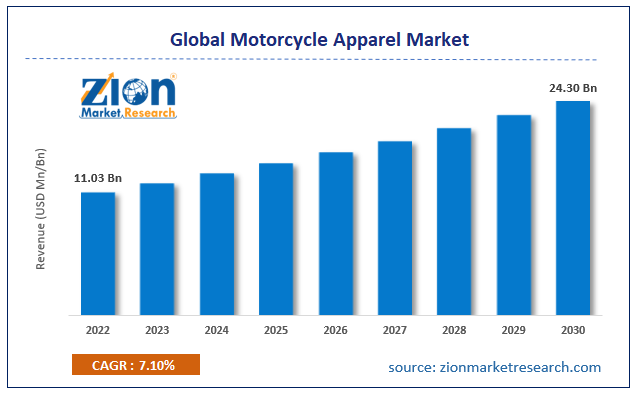Motorcycle apparel is gear designed to make riders safer on the road. New technological applications and ongoing advancements in designs of motorcycle gear are expected to create growth prospects for the market in the long run. In addition, the global sale and popularity of motorcycle apparel have been boosted by the introduction of new technology and continual advancements in design. Style, crisp eyesight, identification, and defense against harsh climates are only some of the other advantages offered by this product.
Motorcycle apparel helps bikers stay safe and reduces accident risk. This clothing provides visual clarity, weather condition, style, identification evidence, and more. The global motorcycle apparel market was $11.03 billion in 2022 and is expected to reach $24.30 billion by 2030 with a CAGR of 7.1%.

The market report compiled by the Zion Market Research team includes in-depth expert analysis, import/export analysis, pricing analysis, production consumption analysis, and consumer behavior in addition to market insights such as market value, growth rate, market segments, geographical coverage, market players, and market scenario.
Product type, end-use, distribution channel, and region divide the worldwide motorcycle apparel market.
The global motorcycle apparel market includes helmets, shoes, gloves, jackets, pants, and base layers. In 2022, the helmets sector accounted for about two-fifths of global market revenue. It is expected to grow the fastest in the next years. Motorbike riders’ desire for helmets may drive segment expansion over the anticipated timeline.
The global motorcycle apparel industry is divided by end-use into on-road and off-road divisions. With a large global market share in 2022, the on-road motorcycle apparel category is predicted to dominate global industry growth over the assessment timeline. The segmental growth over the anticipated timeframe may be because to rising two-wheeler demand in emerging and developed countries.
The global motorcycle apparel market is segmented into store-based and non-store-based categories by distribution channel. The store-based segment, which dominated the global market in 2022, is expected to lead the segmental growth over the forecasted timeline. The easy availability of affordable and luxury biker clothing products fueled segmental growth.
Download Free Sample Report: https://www.zionmarketresearch.com/sample/motorcycle-apparel-market
The global motorcycle apparel market profiles key players such as:
- Yamaha Corporation
- Icon Raiden
- Sidi
- Triumph
- HJC
- Fox Racing Inc.
- Kido
- Alphinestars SPA
- Scott
- Ducati
- AGV
- BMW Motorrad
- Dainese
- Furygan
- Rynox Gears India Private Limited
The global motorcycle apparel market is segmented as follows:
By Product Type
- Helmets
- Shoes
- Gloves
- Jackets
- Pants
- Base Layers
By End-Use
- On-Road Motorcycle Apparel
- Off-Road Motorcycle Apparel
By Distribution Channel
- Store-Based
- Non Store-Based
Asia-Pacific is expected to dominate the global motorcycle apparel market throughout the analysis period.
Over the forecast period, Asia-Pacific will dominate the motorcycle apparel market, which generated 43% of global revenue in 2022. Major motorbike manufacturers including Hondo, TVS, Bajaj, and Hero in India and Japan also contributed to the regional market growth. In the coming years, motorbike sales in India, Indonesia, Thailand, Japan, South Korea, China, and Malaysia will drive market growth.
The North American motorcycle apparel business is expected to grow the fastest due to original equipment manufacturers in nations like the U.S. Canada and the U.S. will likely drive regional revenue in the next years.


